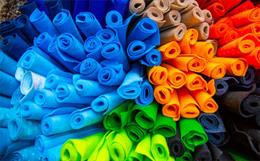Source: China Nonwoven and Industrial Textile Association (CNITA)
1. GeneralDevelopment Trend of Chinese Industrial Textile
In the lastdecade, industrial textile in China has already experienced rapid increase,especially the last five years with annual growth rate of above 18%. In 2007,the output of industrial textile in china was 5443.2 thousand tons, which is906.2 thousand tons more than that of 2006 and occupies 15.4% of the totaloutput of textile fibers. In 2007, the import and export amounts were 27.6 and50.6 billion dollars respectively. The export of industrial textile takes 30%of total output, while the export of non-woven occupies 13% of total yield.Industrial textile has already been applied in agrotech, buildtech, clothtech,hometech, indutech, medtech, mobiltech, oekotech, packtech, protech andsporttech with exclusive technical requirements different from regular clothingand home textile.
2. EconomicStructure and Layout Feature of the Development of Industrial Textile in China
Accordingto the end-use of the product, textile industry can be simply classified intothree main categories of clothing,home textile and industrial textile and the proportion of these categories mayreflect the level of textile technology development. The development ofindustrial textile with more requirements of high technology implies thereasonable structure of textile industry. After more than ten yearsdevelopment, the proportion of industrial textile among the whole textileindustry gradually enhances from 8% in 1990 to 15% in 2007. The increasingpercentage shows the optimized industrial structure of textile, however, bigdifferences still exist as compared with developed countries, as shown in Table1.
| Country | fiber consumption structure [Clothing: Home textile: Industrial Textile] |
| America | 39:39:22 |
| West European | 47:35:18 |
| Japan | 30:31:39 |
| China | 52:33:15 |
3. InternationalCompetitive Ability of industrial textile in China
AlthoughChinese textile and clothing industry has been effected by adjustment of exportrefund rate since 1995, the Chinese government still keeps encouraging theexport of industrial textile by the way of keeping the constant export refundrate of 11%. In recent years, industrial textiles keep pace with clothing andhome textile in the ratio of international market and the internationalcompetitive ability of the whole textile industry keeps enhancing. As can beseen from Table 2, the index of competitive ability of industrial textile keepsrising in the last five years.
Table 2: Index of Competitive Ability of industrial textile in Trading
|
Year |
Import (billion dollars) |
Export (billion dollars) |
Index of Competitive Ability |
|
2003 |
16.59 |
18.21 |
0.046 |
|
2004 |
18.45 |
23.41 |
0.118 |
|
2005 |
20.22 |
31.74 |
0.222 |
|
2006 |
25.48 |
40.05 |
0.222 |
|
2007 |
27.56 |
50.64 |
0.295 |
Compared with the other products of textile industry, the index of competitive ability for industrial textile is still relatively lower. However, the tendency of increase is more obvious than others. It is worth to mention that half amount of the export of textile products belongs to processing and assembling trade which means lower profits along with greater export amount, larger market share and higher competitive index. Hence, accurate assessment of competitive level of textile industry requires the comprehensive consideration of trading amount, price and added value to explore the actual competitive ability of industry.
The industry of industrial textile has characteristics and advantages of intensive capital, high technology, low labor force, qualified worker and huge domestic market, which are totally different from traditional textile industry with intensive labor and poor technology. At present, the exported amount of industrial textile is relatively low and most of the products are still sold in domestic market, which leads to the low competitive index of international trade. In the long run, the industry of industrial textile with high added value and advanced technology will have huge potential market and great competitive ability.
4. Development Forecasting of Industrial textile in China
Along with sound development of national economic, it is forecasted that industry of industrial textile and nonwoven will keep healthy, stable and rapid development. According to National 11th five-year plan, the development goal of annual output in 2010 for industrial textile is 6000 thousand tons. Based on the statistics from CNITA, the annual output in 2007 was 5443.2 thousand tons. The setting output from government will be completed two years earlier than expected, provided that the annual growth rate of 2008 is 18% which is the average annual growth rate in the last five years or 10% for consideration of sluggish global economy. Accelerating the optimization and upgrading of the industrial structure, the industrial textile still has enormous potential room for growth under stable economic development in China, especially for filtration materials, geosynthetic materials, canvas and buildtech. The filtration materials are most likely to fluctuate with the national environment policy. In recent years, the higher environmentally friendly requirement for steel, metallurgy, chemical engineering, cement and coal industry and definite requirement and norm for filter bag and dust settling pocket make the application of filter material more standardizing and offer more potential market for industrial textile.







_Small.png)




